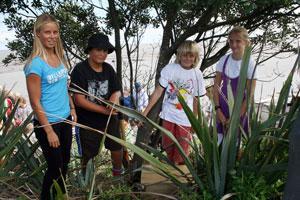Oakura community and the Department of Conservation (DOC) had a project to do and needed some assistance.
As a result of construction along the coastline of the community the little blue penguins were losing their homes. DOC approached Oakura School to see if the students would be interested in constructing and placing boxes to encourage the little blue penguins to return to the area and nest.
In conducting this project, teachers chose to focus on the learning area of science.
The living world strand, particularly ecology and how things are suited to their habitat and how they respond to environmental changes, fitted with the project.
The important concept explored was the sustainability of New Zealand's unique flora and fauna and ecosystem.
Four learning intentions were identified.
- To investigate the environment and adaptations of the little blue penguin.
- To investigate why DOC were promoting the project to put penguin boxes on the beach.
- To identify the threats and predators to the little blue penguin.
- To co-operate with others to create a safe nesting box for a penguin.
Providing sufficient opportunities to learn in science
The teaching team at Oakura School were clear about the scientific knowledge and skills that they wanted their students to develop through the project. They identified clear learning intentions and then planned a series of lessons to ensure that students had time and opportunity to engage with, practice, and transfer new scientific understandings.
The key competencies were brought to the forefront of teaching and learning through this project.
Oakura School principal, Lynne Hepworth, explains, "We have been trying to focus on the key competencies since we received the draft curriculum – what do they mean to us, what do they look like?"
Teachers focused on the key competency participating and contributing by assisting DOC in a project that will better the environment for the whole community.
The values highlighted were community and participation for the common good, and ecological sustainability including care of the environment.
Teachers constructed T-charts with their students around the key competency, what it looks like, and what it sounds like. These were displayed prominently so the students could refer back to them during the project.
Teachers gathered anecdotal evidence to observe the key competency development. At the end of the unit, students reflected on what they had achieved over time. They discussed how they had achieved the values and to what level they participated in the project.
Key competencies
Teachers and students at Oakura School looked in depth at what 'participating and contributing' means and looks like in their school. With appropriate teacher guidance and feedback, students self-monitored and evaluated their use of this key competency to identify future goals.
Many children were extremely passionate about the project because they lived down by the beach and really wanted to be involved.
Some of the penguin boxes were placed on properties that belonged to school families.
Students could see on a daily basis the connection between their schoolwork and their home environment, even those who lived under the mountain and had less immediate access to the penguins. They, too, were keen and understood the community impact.
To add authenticity to the project, Paige Hareb, spokesperson for Seaweek and ex-pupil of Oakura School, helped place more than 20 nesting boxes.
Paige is best known as a surfer on the world scene. She acted as a positive role model for students.
Community engagement principle
Teachers have brought the community engagement principle to life at Oakura school by considering ways to connect learning with their students’ wider lives. They have used a meaningful context for learning which has enabled the school to grow educationally powerful relationships with DOC and use their local environment as an outside classroom.
Where to now?
Oakura school students will have a continued connection with DOC in regards to monitoring the penguin boxes.
The aim is for the students to receive particular strategies for counting little blue penguins, looking for signs of their activities, and reporting these back to DOC.
The vision is to have experts talk to students about the strategies they use to keep track of the penguins.
This is a 'real life' context for learning and an authentic project for participating and contributing to the community. These students have made a difference.
"The key competencies and values are so clearly outlined in The New Zealand Curriculum. It gives us the opportunity to make stronger links. This was such an authentic context for study. The motivation was high and it was practical and hands-on. We feel quite privileged to be a part of this project. It's all about localising our curriculum. We are currently at the stage of reviewing our charter to align our curriculum with the school and community needs. This project fits perfectly with that."
Lynne Hepworth, principal
You might like ...
Learning locally – Connecting kids to their community
Are you looking for ways to explore and develop your local curriculum? One way to get started is to identify the rich learning opportunities that exist in your own community. This blog offers some ideas, stories, and questions to help your students “learn locally”.
- Tags:
- community engagement
- key competencies
- primary
- science
Return to top


